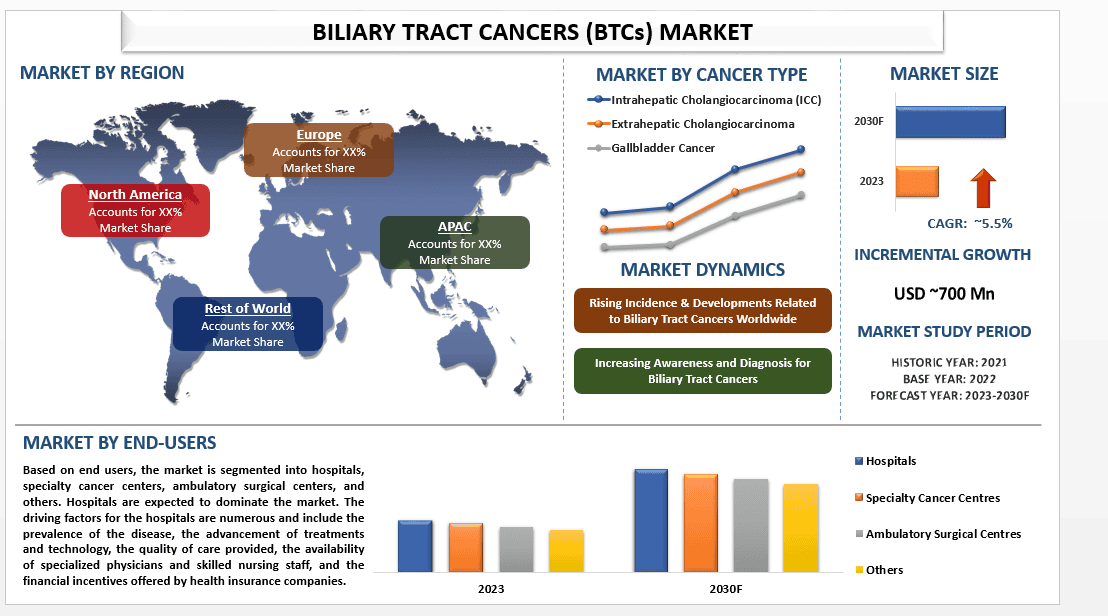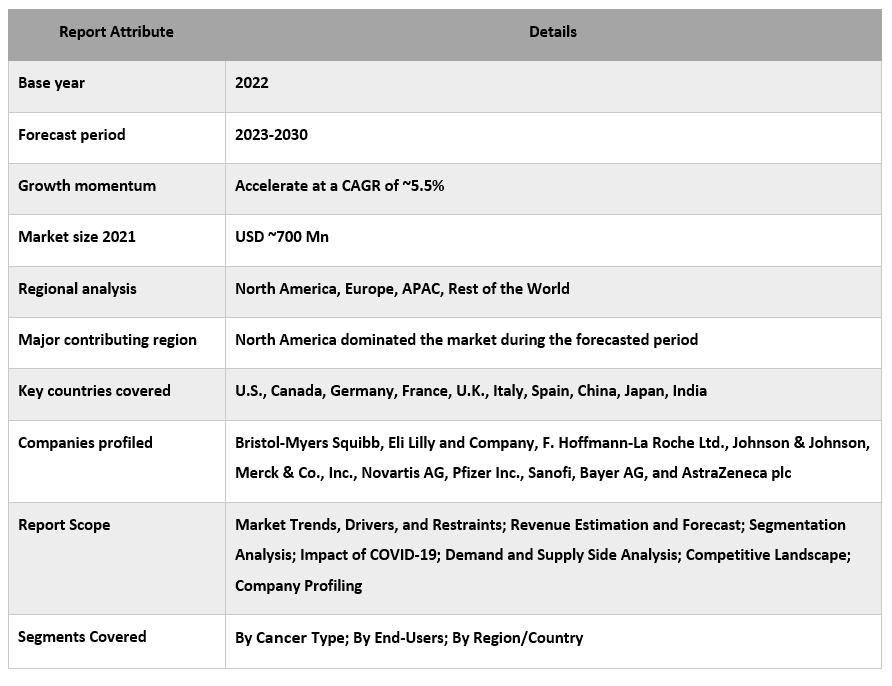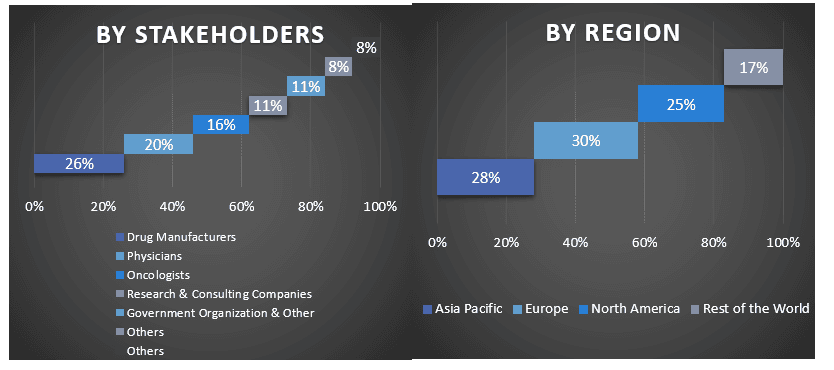- Home
- About Us
- Industry
- Services
- Reading
- Contact Us
Biliary Tract Cancers (BTCs) Market: Current Analysis and Forecast (2023-2030)
Emphasis on Cancer Type (Intrahepatic Cholangiocarcinoma (ICC), Extrahepatic Cholangiocarcinoma, and Gallbladder Cancer); End-Users (Hospitals, Specialty Cancer Centres, Ambulatory Surgical Centres, Others); and Region/Country

The Biliary Tract Cancers (BTCs) Market is expected to grow at a strong CAGR of ~5.5% during the forecast period 2023-2030. The market is influenced by various factors, including the increasing prevalence and incidence of BTCs, advancements in diagnostic technologies, evolving treatment approaches, growing awareness and screening programs, collaborative research efforts, favorable reimbursement policies, and the growing geriatric population. Despite the challenges posed by the pandemic, healthcare providers and researchers have been actively working to mitigate its impact and ensure the best possible outcomes for BTC patients. Ongoing efforts are focused on early detection, innovative treatment approaches, and enhancing patient care and support. The BTCs market is a dynamic and evolving landscape, with continuous research, technological advancements, and collaborative efforts driving progress. It is crucial for healthcare professionals, researchers, and stakeholders to stay updated with the latest developments and work together to improve the diagnosis, treatment, and overall management of BTCs.
Some of the major players operating in the market include Bristol-Myers Squibb, Eli Lilly and Company, F. Hoffmann-La Roche Ltd., Johnson & Johnson, Merck & Co., Inc., Novartis AG, Pfizer Inc., Sanofi, Bayer AG, and AstraZeneca plc.
Insights Presented in the Report
“Amongst cancer type, the sutures category is expected to dominate the market”
Based on cancer type, the market is segmented into intrahepatic cholangiocarcinoma (ICC), extrahepatic cholangiocarcinoma, and gallbladder cancer. Gallbladder cancer segment dominated the market during the forecast period, as it is the most common malignancy of the biliary tract and is associated with high mortality rates. Its prevalence varies across different regions, with higher rates reported in certain countries such as India, Chile, and parts of East Asia. This higher incidence contributes to a larger patient population and greater attention within the medical community, driving research, treatment development, and market focus.
Biliary Tract Cancers (BTCs) Market Report Coverage

“North America dominated the Biliary Tract Cancers (BTCs) Market in 2022”
North America has shown a strong presence in the Biliary Tract Cancers (BTCs) market. Several factors contribute to North America’s dominance in this market. North America is known for its well-developed healthcare infrastructure, including hospitals, clinics, research institutions, and specialized centers. Biliary tract cancers are relatively rare compared to other types of cancers, but they represent a significant health concern in North America. The incidence of BTCs varies across the region, with some areas experiencing higher rates than others. The prevalence of biliary tract cancers is influenced by factors such as age, gender, ethnicity, and geographical location.
North America is home to several major players in the medical device industry. These companies often have established distribution networks, market presence, and partnerships with healthcare providers, contributing to the dominance of the region in the Biliary Tract Cancers (BTCs) market.
Reasons to buy this report:
- The study includes market sizing and forecasting analysis validated by authenticated key industry experts.
- The report presents a quick review of overall industry performance at one glance.
- The report covers an in-depth analysis of prominent industry peers with a primary focus on key business financials, product portfolios, expansion strategies, and recent developments.
- Detailed examination of drivers, restraints, key trends, and opportunities prevailing in the industry.
- The study comprehensively covers the market across different segments.
- Deep dive regional level analysis of the industry.
Customization Options:
The global Biliary Tract Cancers (BTCs) market can further be customized as per the requirement or any other market segment. Besides this, UMI understands that you may have your own business needs, hence feel free to connect with us to get a report that completely suits your requirements.
Table of Content
Research Methodology for the Biliary Tract Cancers (BTCs) Market Analysis (2023-2030)
Analyzing the historical market, estimating the current market, and forecasting the future market of the global Biliary Tract Cancers (BTCs) market were the three major steps undertaken to create and analyze the adoption of Biliary Tract Cancers (BTCs) in major regions globally. Exhaustive secondary research was conducted to collect the historical market numbers and estimate the current market size. Secondly, to validate these insights, numerous findings and assumptions were taken into consideration. Moreover, exhaustive primary interviews were also conducted, with industry experts across the value chain of the global Biliary Tract Cancers (BTCs) market. Post assumption and validation of market numbers through primary interviews, we employed a top-down/bottom-up approach to forecasting the complete market size. Thereafter, market breakdown and data triangulation methods were adopted to estimate and analyze the market size of segments and sub-segments of the industry pertains to. Detailed methodology is explained below:
Analysis of Historical Market Size
Step 1: In-Depth Study of Secondary Sources:
Detail secondary study was conducted to obtain the historical market size of the Biliary Tract Cancers (BTCs) market through company internal sources such as annual reports & financial statements, performance presentations, press releases, etc., and external sources including journals, news & articles, government publications, competitor publications, sector reports, third-party database, and other credible publications.
Step 2: Market Segmentation:
After obtaining the historical market size of the Biliary Tract Cancers (BTCs) market, we conducted a detailed secondary analysis to gather historical market insights and share for different segments & sub-segments for major regions. Major segments are included in the report as cancer type and end-users. Further country-level analyses were conducted to evaluate the overall adoption of testing models in that region.
Step 3: Factor Analysis:
After acquiring the historical market size of different segments and sub-segments, we conducted a detailed factor analysis to estimate the current market size of the Biliary Tract Cancers (BTCs) market. Further, we conducted factor analysis using dependent and independent variables such as cancer type and end-users of the Biliary Tract Cancers (BTCs) market. A thorough analysis was conducted of demand and supply-side scenarios considering top partnerships, mergers and acquisitions, business expansion, and product launches in the Biliary Tract Cancers (BTCs) market sector across the globe.
Current Market Size Estimate & Forecast
Current Market Sizing: Based on actionable insights from the above 3 steps, we arrived at the current market size, key players in the global Biliary Tract Cancers (BTCs) market, and market shares of the segments. All the required percentage shares split, and market breakdowns were determined using the above-mentioned secondary approach and were verified through primary interviews.
Estimation & Forecasting: For market estimation and forecast, weights were assigned to different factors including drivers & trends, restraints, and opportunities available for the stakeholders. After analyzing these factors, relevant forecasting techniques i.e., the top-down/bottom-up approach were applied to arrive at the market forecast for 2028 for different segments and sub-segments across the major markets globally. The research methodology adopted to estimate the market size encompasses:
- The industry’s market size, in terms of revenue (USD) and the adoption rate of the Biliary Tract Cancers (BTCs) market across the major markets domestically
- All percentage shares, splits, and breakdowns of market segments and sub-segments
- Key players in the global Biliary Tract Cancers (BTCs) market in terms of products offered. Also, the growth strategies adopted by these players to compete in the fast-growing market
Market Size and Share Validation
Primary Research: In-depth interviews were conducted with the Key Opinion Leaders (KOLs) including Top Level Executives (CXO/VPs, Sales Head, Marketing Head, Operational Head, Regional Head, Country Head, etc.) across major regions. Primary research findings were then summarized, and statistical analysis was performed to prove the stated hypothesis. Inputs from primary research were consolidated with secondary findings, hence turning information into actionable insights.
Split of Primary Participants in Different Regions

Market Engineering
The data triangulation technique was employed to complete the overall market estimation and to arrive at precise statistical numbers for each segment and sub-segment of the global Biliary Tract Cancers (BTCs) market. Data was split into several segments & sub-segments post studying various parameters and trends in the areas of the cancer type and end-users in the global Biliary Tract Cancers (BTCs) market.
The main objective of the Global Biliary Tract Cancers (BTCs) Market Study
The current & future market trends of the global Biliary Tract Cancers (BTCs) market were pinpointed in the study. Investors can gain strategic insights to base their discretion for investments on the qualitative and quantitative analysis performed in the study. Current and future market trends determined the overall attractiveness of the market at a regional level, providing a platform for the industrial participant to exploit the untapped market to benefit from a first-mover advantage. Other quantitative goals of the studies include:
- Analyze the current and forecast market size of the Biliary Tract Cancers (BTCs) market in terms of value (USD). Also, analyze the current and forecast market size of different segments and sub-segments
- Segments in the study include areas of the cancer type and end-users
- Define and analysis of the regulatory framework for the Biliary Tract Cancers (BTCs) industry
- Analyze the value chain involved with the presence of various intermediaries, along with analyzing customer and competitor behaviors of the industry
- Analyze the current and forecast market size of the Biliary Tract Cancers (BTCs) market for the major region
- Major countries of regions studied in the report include Asia Pacific, Europe, North America, and the Rest of the World
- Company profiles of the Biliary Tract Cancers (BTCs) market and the growth strategies adopted by the market players to sustain in the fast-growing market
- Deep dive regional level analysis of the industry
Related Reports
Customers who bought this item also bought










